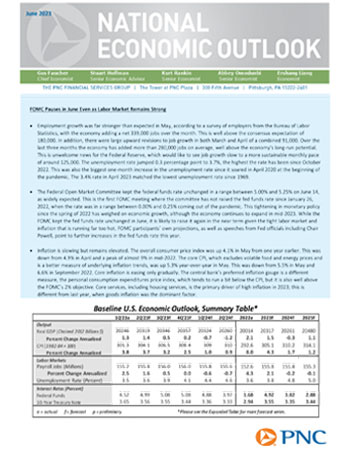La información contenida en este sitio es a saber y entender de PNC Bank, correcta y precisa, pero PNC Bank no declara, manifiesta ni garantiza su exactitud. Cualquier descarga de material contenido en este sitio o de cualquier sitio vinculado a este sitio puede ser una violación de las leyes federales de marcas comerciales y derechos de autor.
Perspectiva económica nacional de PNC
Marzo de 2024
El FOMC prepara el terreno para recortes de las tasas más adelante este año, ya que el mercado laboral se mantiene muy fuerte a principios de 2024
La economía estadounidense añadió 275,000 empleos en febrero, según una encuesta de empleadores realizada por la Oficina de Estadísticas Laborales. Sin embargo, se produjeron grandes revisiones a la baja del crecimiento del empleo en enero y febrero, que sumaron 167,000 puestos. En los tres últimos meses, el crecimiento promedio del empleo ha sido de 265,000 puestos, muy por encima del ritmo anterior a la pandemia. El sector privado sumó 223,000 puestos de trabajo en febrero, frente a los 177,000 de enero.
La tasa de desempleo subió al 3.9% en febrero, frente al 3.7 % de los tres meses anteriores. La tasa de desempleo se ha mantenido por debajo del 4 % durante más de 2 años consecutivos, lo que representa la racha más larga de este tipo desde finales de la década de 1960.
Los ingresos promedio por hora solo aumentaron un 0.1 % en febrero respecto a enero, y el crecimiento salarial de enero se revisó a la baja, del 0.6 % al 0.5 %; también se revisó a la baja el crecimiento salarial de diciembre. En términos interanuales, los salarios promedio por hora aumentaron un 4.3 % en febrero, frente al 4.4 % de enero (tras las revisiones). El menor crecimiento salarial está contribuyendo a la ralentización de la inflación.
El índice de precios de los gastos de consumo personal aumentó un 0.3 % en febrero, tras subir un 0.4 % en enero. El índice de precios PCE básico, que excluye los precios de los alimentos y la energía y es la medida de inflación preferida de la Reserva Federal, subió un 0.3 % en febrero (0.26 % antes del redondeo), por debajo del 0.5 % mensual de inflación subyacente registrado en enero.
En términos interanuales, la inflación general medida por el índice PCE fue del 2.5 % en febrero, por encima del 2.4 % de enero, pero por debajo del 3 % alcanzado recientemente en septiembre de 2023 y de un máximo cíclico superior al 7 % a mediados de 2022.
La inflación del PCE básico fue del 2.8 % interanual en febrero, frente al 2.9 % de diciembre, y superior al 3 % en una fecha tan reciente como noviembre de 2023. La inflación del PCE básico superó el 5 % a mediados de 2022. La inflación se mantiene por encima del objetivo del 2 % de la Reserva Federal, pero se está ralentizando.
Ante la desaceleración de la inflación, el Comité Federal de Mercado Abierto (FOMC) espera recortar la tasa de los fondos federales, la principal tasa a corto plazo del Comité, en algún momento de este año. El FOMC no anunció ningún cambio en la tasa de los fondos federales tras su reunión de política de 20 de marzo. Pero el Resumen de proyecciones económicas, o diagrama de puntos, publicado después de la reunión, apunta a algunos recortes de tasas en 2024.
La proyección mediana de la tasa de los fondos federales a fines de 2024 es del 4.6 %, lo que sugiere tres recortes de 25 puntos básicos en la tasa de los fondos federales este año. Pero diez participantes mostraron tres o más recortes de las tasas este año, mientras que nueve mostraron dos o menos, lo que indica que los participantes están divididos entre 2 y 3 recortes de tasas en 2024.
La mediana de la tasa de los fondos federales prevista para fines de 2025 era del 3.9 % en el diagrama de puntos de 20 de marzo, frente al 3.6 % del anterior, a mediados de diciembre.


